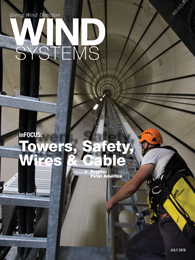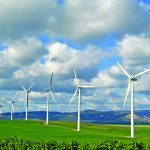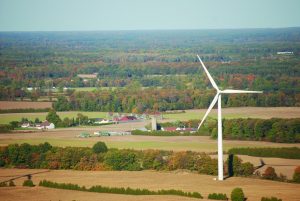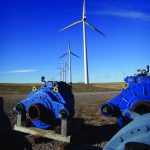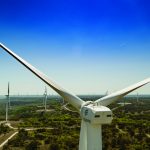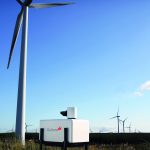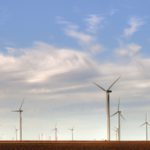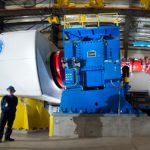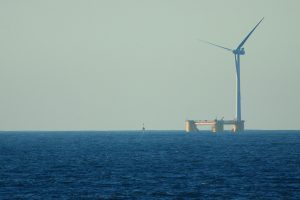Current transducers are a key electronic component of wind-energy turbine converters. They assist the power control system, protect the drive, and help feed energy into the grid system at a controlled frequency and voltage.
Innovations in current transducer design are spurring the adoption of smart grid technologies and improving the performance of turbines and other power applications from generation and transmission to efficiency and monitoring. Improved manufacturing techniques, combined with custom ASIC chips have made it possible to achieve fluxgate-level performance from less costly closed loop Hall-effect sensors.

Current transducers
Turbine active power control systems commonly use low-power electrical drives to adjust rotor blades as needed. As part of the converter’s closed loop control, PCB-mounted current transducers are able to respond rapidly.
In the yaw control systems, transducers are continuously measuring the current order to position the drive for optimum generation. The quality and response time of these systems are influenced by the design and performance of the current transducers. The inherent advantages of closed-loop current transducers — high bandwidth, short response time, and very good linearity — makes them ideal for this application.
Closed-loop transducers also are well-suited to help deliver the electrical power from the turbine to the grid. Precise and fast current detection is necessary in order to control the power feeding back to the grid, while also monitoring the voltage of the DC link. By using the closed-loop principle, a fast response medium-current transducer can provide short-circuit protection of the power semiconductors in the inverters — an invaluable advantage for wind-energy turbines in offshore areas where the maintenance is difficult and expensive.
Combining Hall-effect and ASIC technology
The simplest current transducers are open-loop devices in which the magnetic field from the primary current is sensed and amplified; though open-loop offset and gain can drift over extreme operating temperature.

Although closed-loop devices are more complex, they provide improved performance by canceling the primary magnetic field with a secondary compensation current in a coil of N turns. With the gain of the device set by the number of turns, N, it is precise and stable even over temperature. The transformer effect takes over the feedback loop when the primary current frequency is above a few kilohertz, providing an effective bandwidth that is much higher than the noise bandwidth. By always operating at zero magnetic field, the linearity is intrinsically good, and the response time, driven by the transformer effect, is very fast.
Closed loop transducer designs use Hall cells as the magnetically sensitive element. Hall cells provide fast and accurate current measurements but also have one weakness: the offset voltage (VOUT – VREF with zero primary current) and its drift over temperature. One solution is to use a fluxgate detector instead of the Hall-effect chip, which improves stability over varying temperatures. However, fluxgate technology adds additional complexity and price.

Efforts to boost Hall-effect technology to fluxgate-level performance has led LEM to develop a proprietary Application Specific Integrated Circuit (ASIC) for use in closed-loop mode. In addition, the spinning technique and specialist integrated circuit used by LEM overcomes other drawbacks such as noise, start-up time before measuring current present on the primary, and restarting without delay after an overload.
For accurate measurement of DC currents, the technology compensates the current linkage QP created by the current IP to be measured by an opposing current linkage QS created by a current IS flowing through a known number of turns NS to obtain:
QP − QS = 0 or NP·IP − NS·IS = 0
with NP the number of primary turns and NS the number of secondary turns.
To obtain accurate measurement, it is necessary to have a highly accurate device to measure the condition Q = 0 precisely.
To achieve accurate compensation of the two opposing current linkages (QP and QS), a detector capable of accurately measuring Q = 0 must be used, which means the detector must be very sensitive to small values of a residual magnetic flux g (created by the current linkage Q) to achieve the greatest possible detector output signal.

Thanks to the partial air gap of the magnetic core, newer current transducers have a very low sensitivity to external AC and DC fields. This allows for a more compact design as there is practically no sensitivity to high current conductors near to the transducer. The magnetic core with a partial air gap improves the magnetic coupling and improves the response against di/dt.
The sensitivity against AC or DC fields (worst case) with ASIC enhanced technology is five times better than with the former generations using a classic Hall effect chip. The typical error with ASIC transducers is 2 percent of IPN compared with 10 percent for non-ASIC current measurements when submitted to the same conditions caused by AC or DC perturbating fields.
Improved performance
Using the closed-loop operating principle in association with ASIC, LEM has been able to achieve improved accuracy, external field sensitivity and measuring range in several current transducer designs commonly used in wind turbines.
The LF series covers nominal current measurements from 200 to 2,000A (4,000A peak) and only require a standard DC power supply range of ±11.4 to ±25.2V. Sensitivity error at +25˚C is ±0.1% and linearity is only ±0.1%.
The compact, low-current LESR series is particularly well suited to applications where low offset drift is important, such as the yaw control for wind turbines or in the AC output of solar power installations where standards require a very low DC component in the output current.

In order to give the best high-frequency performance, two secondary coils wound in series are used. A special time-saving winding technique is used to avoid any soldered connections between the two coils. An on-chip memory stores corrections for any residual offset — or other imperfections — found during the production of each transducer. Both series have excellent accuracy over their entire operating temperatures.
The LESR series also features a patented arrangement of multiple Hall cells in a symmetrical layout merged with the first amplifier stages, and employs sophisticated offset canceling techniques in the control loop to generates the secondary compensation current.
These improvements result in offset drift over four times smaller than previous generations of Hall-effect sensors, and very close to that of fluxgate sensors.
Conclusion
In the search for the increased efficiency, wind-energy systems can benefit from transducers employing ASIC technology. With high immunity to external interferences generated by adjacent currents or external perturbations, these transducers are suitable for any kind of rugged environment where good performance in terms of accuracy, gain, linearity, low initial offset, and low thermal drift is required.
















